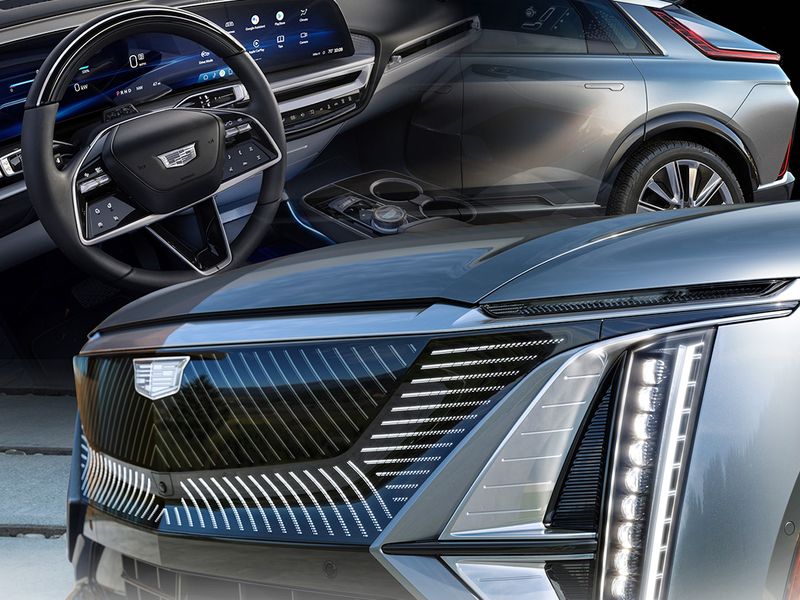
DETROIT — Cadillac is setting a new design tone with the Lyriq, the electric vehicle that will be a launch pad toward its plan to eliminate internal combustion engines by 2030.
The crossover, due out early next year, kicks off the latest of many reinvention efforts that have had varying levels of success for the General Motors luxury brand in recent decades. But the conversion to all EVs is not the kind of transformation that can be easily unwound or brushed aside later if brand leaders’ execution falls short.
Designers borrowed embellishments from Cadillac’s heritage while leveraging the styling freedom created by the new battery architecture to give the Lyriq a low, wide stance. They added touches such as a lined jewelry drawer and a cantilever console inspired by grand balconies. Each component of the midsize crossover — and all future Cadillac EVs — is unique. It won’t share parts with Chevrolet, Buick or GMC.
“We’ve got a whole strategy of how we want to develop Cadillacs to be Cadillacs first and foremost,” said Andrew Smith, executive director of Cadillac global design. “That really means that we’ve got a component set, a sharing strategy, even a manufacturing strategy that’s very much dedicated for Cadillac.”
Cadillac will open customer reservations Saturday, Sept. 18, for the launch edition of the Lyriq. After reservations are full, Cadillac will shift to a traditional dealer allocation model.
Cadillac communicated its design aspirations with the Escala concept car, which debuted at the 2016 Pebble Beach Concours d’Elegance. The Lyriq is the next step, Smith said.
GM’s proprietary Ultium battery architecture with stackable pouches allowed Cadillac to build the Lyriq with a wide wheelbase. The batteries lie flat underneath the floor.
“This car has got the wheels pushed to every corner,” Smith said. “It’s got the dash to axle that we all love, and it’s got a great stance. It’s kind of the car we always wanted to be able to do, but now we actually have the ability to do it.”
Although the Lyriq is the first EV in the next generation of all-electric Cadillacs, designers don’t want customers to think “EV” when they see the Lyriq. “Cadillac” should come to mind first, Smith said.
EVs need to be approachable to accelerate adoption, said Stephanie Brinley, principal analyst at IHS Markit. “It needs to be something that people can see themselves in today,” she said. “I think Cadillac achieves that.”
Unlike other EVs in the market, the Lyriq doesn’t have a cargo space beneath the hood, known as a frunk. Instead, Cadillac rearranged components to carve out a large storage compartment in the rear, where the trunk is on a sedan. The front of the vehicle contains a 19.2-kilowatt onboard charging module and a 12-volt battery.
“I wanted this to be as much like a regular car as it could possibly be, just better,” Smith said. “The cargo volume you’ll see is really, really big. Any modules that we had left over, we’ve actually packaged them in the front.”
The Lyriq is noticeably distinct from gasoline-powered vehicles in other ways.
A standard grille is unnecessary for EVs, but Cadillac designers wanted the Lyriq to have a face. So the front has sensors packaged behind a black-painted surface. When the driver approaches the vehicle, lighting choreography begins with a Cadillac crest in the center and fans out the width of the vehicle.
The Lyriq maintains many traditional brand style cues, but Cadillac differentiated the Lyriq in “the way that they’re using lighting to express the modernity of the vehicle and to express how it’s leading into the next phase for Cadillac,” Brinley said.
Inside the Lyriq, designers prioritized space and personal touches. They repackaged HVAC systems, moved airbags and lowered instrument panels to make the Lyriq feel spacious. Near the driver is a lined area large enough for a purse or grocery bag and a hidden jewelry box. The additional storage space was available in part because of a unique console design inspired by cantilever balconies, said Tristan Murphy, manager of Cadillac interior design.
“We pulled up images of fictitious buildings you see in movies where they’ve got these long cantilever balconies. There’s something dramatic and very exciting when you see something like that,” he said. The team thought, “How do we evoke some of those same feelings, even on a subconscious level, that are going to give you that drama?”
The Lyriq has seat controls on the door, rather than the side of the seat. The relocation was an engineering challenge but allows for wider seats and is more convenient for the driver.
Various Cadillac emblems appear throughout the Lyriq. Designers visited GM’s Heritage Center for inspiration.
“If you know more about the history of what you own, then you kind of feel like you’re a little bit of that club,” Brinley said. “Those little bits communicate an attention to detail. They communicate a passion and an interest in the brand and what they’re doing.”
The original 1902 Cadillac crest featured six ducklings, known as merlettes. The Lyriq has three merlettes etched into the driver’s side panel and three on the passenger side.
“It’s just a nice little wink and a nod to our past. There’s so many startups. They’re all groundbreaking and new,” said Murphy. “We actually do have this amazing history that we can pull from and have a little bit of fun.”